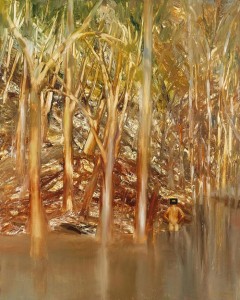 I went to visit the Sidney Nolan: A New Retrospective exhibition at the Queensland Art Gallery yesterday. I didn’t know much about Nolan except for his famous Ned Kelly paintings.
I went to visit the Sidney Nolan: A New Retrospective exhibition at the Queensland Art Gallery yesterday. I didn’t know much about Nolan except for his famous Ned Kelly paintings.
(For non-Australians, Ned Kelly was a famous bushranger (highway robber) who was hanged in the late nineteenth century, and is still an iconic Australian figure today – Nolan’s paintings of him were used as the basis for costumes of some of the dancers in the Sydney 2000 Olympic Games opening ceremony).
Of course, seeing the images on screen is unsatisfactory compared to seeing the real thing, but if you’d like to browse some of Nolan’s work you can start here at a Google image search.
While I admire Nolan’s technical skill, I kept feeling that much of Nolan’s work – especially after his early period – both represents and re-inforces an Australian cult of failure that is one of the most damaging forces standing against a progressive culture in Australia today.
One example of this is the Riverbend polyptych (a work of art containing “many panels”). One of the panels from Riverbend II, a similar work, can be seen here, and a crack team of revolutionary art critics armed with shoe cameras and dodging security guards took this clip of the whole 9-panel-work, over 9 metres wide.
You can’t see the detail very well in the video, but you can get some idea of the sheer overwhelming size of the work. In most of the panels, redgums push close to the edge of the river, while tiny (in comparison) figures of Ned Kelly shoot at tiny figures of policemen. In the far-right panel, the trees recede and you can see open river – I felt a physical sense of relief while I looked at this panel, after the oppressive closeness of the rest. The message I got from this work is that there is no room for people in this landscape.
According to an art book I flicked through at the exhibition, three of Nolan’s major themes were Kelly, the failed Gallipoli invasion of 1915 (which bent the spine of Australia’s optimism for decades to come) and the failed Burke and Wills expedition to the Australian desert in the middle of the nineteenth century – an attempt to cross the continent from north to south and back again.
Nolan didn’t make any of these things famous – he merely picked up on what was around him (and in fact I remember learning about all of these things at school, as would many other Australians). But he did decide (or, because of who he was, was inspired) to use them as recurring themes in his work. But surely he was re-inforcing the pessimism and cynicism of a country that was far better at making icons and heroes out of people who failed, rather than those who succeeded (how many legends are told of the successful Australian actions on the Western Front in WWI, compared to the bloody failure at Gallipoli?)
This got me thinking about the relationship between culture and individual decisions. Nolan wasn’t acting in a cultural vacuum. Was/Is it possible for an artist or a movement of artists to have any effect at all on cultural norms? What if a master artist in Australia’s history had chosen to consistently paint and represent success? Would this have even been possible? Would she have been ignored? How does culture change, and what role do individual decisions have in that?
All this, has implications for the creation of a pre-revolutionary culture in a bourgeois society. Is it possible to create inspiring and successful works that actually convince people to change their attitudes a bit, or at least to emphasise some attitudes that were previously buried?

The novel What is to be Done? had a huge influence in pre-revolutionary Russia. It sold the idea of supreme optimism and dedication to the revolution, to a lot of people.